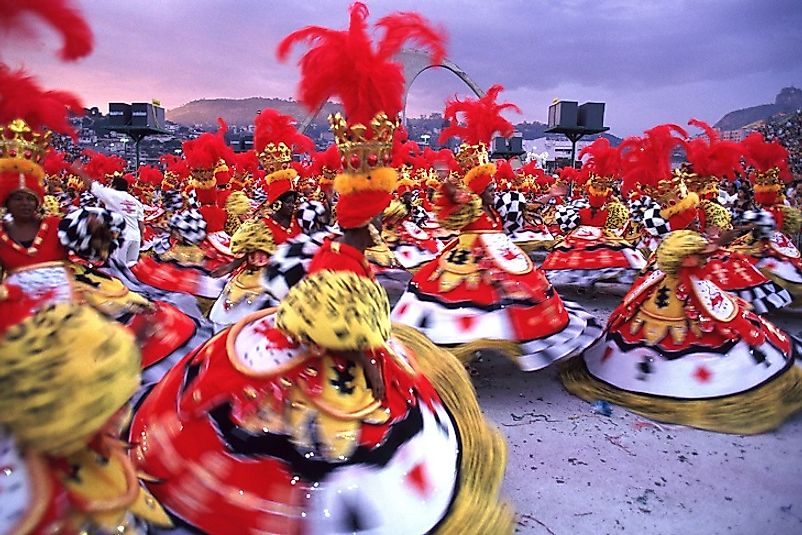Brazilian Carnival - Festivals From Around The World

Overview
The Carnival of Brazil is an annual event held at the South American country of Brazil that is well known for its spectacular and colorful parades, lively music, and dance and large-scale participation by people from all parts of the world, transcending all cultural boundaries. The week-long festivities are held during the days prior to Lent, ending before Ash Wednesday at noon. The carnival is celebrated in distinct styles in different cities and towns of the country. The Brazilian Carnival celebrations at Rio de Janeiro, Vitória, Salvador, Recife, and São Paulo are among the most famous of these carnival events that attracts thousands of international tourists to these cities during the carnival period.
History
The Brazilian Carnival is inspired by the Portuguese tradition of celebrating life prior to the beginning of the solemn period of Lent which involves abstinence from the luxuries of life and strict adherence to spiritual and religious principles involving prayers, penance, charity, and repentance. The carnival celebrations thus date back to the early 19th Century when the Portuguese settlers in the country would indulge in food, drinks, dancing, singing, and parading before Lent. By the late 19th Century, the celebrations became more widespread and large-scale street performances and parades began to be arranged, drawing large crowds to enjoy the festivities. Since then, there has been no looking back and today the Brazilian Carnival earns the country huge income from tourist revenue.
Carnival Variances Across Brazil
The Brazilian Carnival offer unique flavors at the different regions where it is celebrated. The most popular celebrations are held at the famous port city of Rio de Janeiro. Over 100 block parades are the major attraction of the festival. These parades are primarily organised by the city’s Samba schools, their staff, and students. Every neighborhood in the city has its own parade involving participants dressed up in vibrant costumes, themed Samba music and dance, floats and props, all with an excellent visual appeal. Competitions are held between these parading groups and at the end, winners are rewarded. In Bahai, the carnival is heavily influenced by African culture and incorporates traditional African music like reggae with Brazilian samba. In Pernambuco, the Carnival is again associated with an African influence. The carnival at Pernambuco’s capital of Recife is considered to be one of the biggest carnival parades in the world. In Sao Paolo, samba schools compete against each other in the carnival and present different themes related to the history, culture, and politics of the region. Other places in Brazil like Vitória, Minas Gerais, Manaus, and Uruguaiana also celebrate the Carnival in their own unique ways.
Festivities of Carnival
Samba music is an integral part of the Brazilian Carnival. This style of music originated in Bahia and evolved in Rio. The first samba school in the country was established in the 1930’s. Soon, more such schools cropped up and started transforming samba into the drum parade form that is the primary attraction of the Carnival parades today. Since the 1930’s, the samba underwent many transformations into distinct styles like the bossa nova, disco, Brazilian rock, pagode, and others. All such styles were displayed at some point of time in the Brazilian Carnival events. Freco is another musical style that is a part of the Brazilian Carnival. Freco developed in Recife and Olinda in the 19th Century and soon became popular throughout the nation. The first display of the fresco style in the Carnival was initiated by Brazilian Army bands who paraded in the festival. Another important part of the Carnival event is the elaborate and spectacular costumes worn by the parade participants. The vibrant costumes and unique styles are eye-catchy and heavily photographed by the tourists at the festival. The floats and props used in the Carnival parade are also another attraction of the parade. The floats and adornments pertain to the theme of the parade and are one of the categories on the basis of which the best parades in the Rio Carnival are judged. Carnival Balls are also held across the cities hosting the Brazil Carnival to allow the tourists and public to participate in the festivities.
Tourism
Over the years, the Brazilian Carnival has been highly popularized and currently draws crowds from all corners of the globe to Brazil each year. The greatest volume of crowd arrives at Rio de Janeiro, also known as the “Carnival Capital of the World”. Every year, an average of around 500,000 international tourists arrive at Rio to participate and witness its colorful Carnival celebrations. Other parts of Brazil celebrating the carnival also receives a huge volume of tourists. In 2015, the number of tourists attending the Rio De Janeiro Carnival skyrocketed to 977,000 and earned the city a revenue of $782 million USD. Sao Paolo also hosted nearly a million visitors during its carnival period in 2015. Other sites in Brazil hosting the Brazil Carnival also receive significant tourist footfall during the carnival days accompanied with huge income from tourist revenue.











